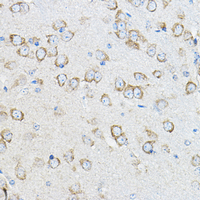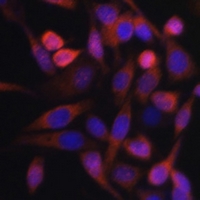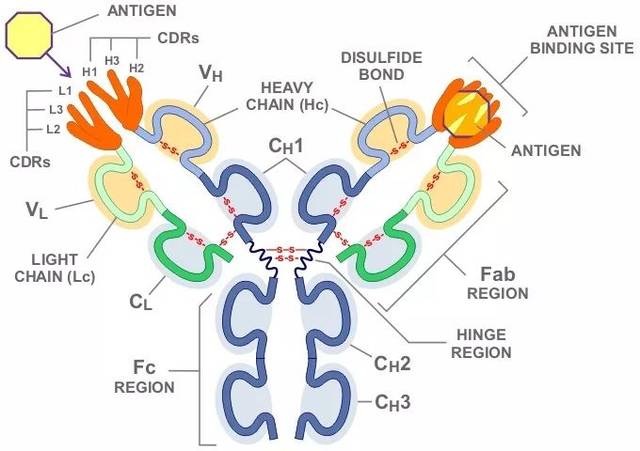Product Name :
Stim1 polyclonal antibody Background :
Ca2+ is a key second messenger in many intracellular signaling pathways. Ca2+ signals control many cellular functions ranging from short-term responses such as contraction and secretion to longer-term regulation of cell growth and proliferation. Stromal interaction molecules (STIMs) function as Ca2+ sensors that detect changes in Ca2+ content in intracellular Ca2+ stores. STIM1 is conserved, ubiquitously expressed, and functions as an endoplasmic reticulum (ER) Ca2+ sensor that migrates from the ER Ca2+ store to the plasma membrane where it activates calcium-release-activated calcium (CRAC) channels when the ER Ca2+ store is low. STIM1 is a potential tumor suppressor; defects in STIM1 may cause rhabdomyosarcoma and rhabdoid tumors. STIM1 can either homodimerize or form heterodimers with STIM2. STIM2 possesses a high sequence identity to STIM1 and can function as an inhibitor of STIM1-mediated plasma membrane store-operated Ca2+ entry. However, further investigation is required to elucidate the true physiological function of STIM2 Product :
Liquid in 0.42% Potassium phosphate, 0.87% Sodium chloride, pH 7.3, 30% glycerol, and 0.01% sodium azide. Storage&Stability :
Store at 4°C short term. Aliquot and store at -20°C long term. Avoid freeze-thaw cycles. Specificity :
Recognizes endogenous levels of Stim1 protein Immunogen :
Recombinant fusion protein of human Stim1. The exact sequence is proprietary. Conjugate :
Unconjugated Modification :
Unmodification
Stim1 polyclonal antibody Background :
Ca2+ is a key second messenger in many intracellular signaling pathways. Ca2+ signals control many cellular functions ranging from short-term responses such as contraction and secretion to longer-term regulation of cell growth and proliferation. Stromal interaction molecules (STIMs) function as Ca2+ sensors that detect changes in Ca2+ content in intracellular Ca2+ stores. STIM1 is conserved, ubiquitously expressed, and functions as an endoplasmic reticulum (ER) Ca2+ sensor that migrates from the ER Ca2+ store to the plasma membrane where it activates calcium-release-activated calcium (CRAC) channels when the ER Ca2+ store is low. STIM1 is a potential tumor suppressor; defects in STIM1 may cause rhabdomyosarcoma and rhabdoid tumors. STIM1 can either homodimerize or form heterodimers with STIM2. STIM2 possesses a high sequence identity to STIM1 and can function as an inhibitor of STIM1-mediated plasma membrane store-operated Ca2+ entry. However, further investigation is required to elucidate the true physiological function of STIM2 Product :
Liquid in 0.42% Potassium phosphate, 0.87% Sodium chloride, pH 7.3, 30% glycerol, and 0.01% sodium azide. Storage&Stability :
Store at 4°C short term. Aliquot and store at -20°C long term. Avoid freeze-thaw cycles. Specificity :
Recognizes endogenous levels of Stim1 protein Immunogen :
Recombinant fusion protein of human Stim1. The exact sequence is proprietary. Conjugate :
Unconjugated Modification :
Unmodification
-
 Western blot analysis of Stim1 expression in HeLa (A), mouse brain (B), mouse heart (C) whole cell lysates.
Western blot analysis of Stim1 expression in HeLa (A), mouse brain (B), mouse heart (C) whole cell lysates. -
 Immunohistochemical analysis of Stim1 staining in mouse brain formalin fixed paraffin embedded tissue section. The section was pre-treated using heat mediated antigen retrieval with sodium citrate buffer (pH 6.0). The section was then incubated with the antibody at room temperature and detected using an HRP conjugated compact polymer system. DAB was used as the chromogen. The section was then counterstained with haematoxylin and mounted with DPX.
Immunohistochemical analysis of Stim1 staining in mouse brain formalin fixed paraffin embedded tissue section. The section was pre-treated using heat mediated antigen retrieval with sodium citrate buffer (pH 6.0). The section was then incubated with the antibody at room temperature and detected using an HRP conjugated compact polymer system. DAB was used as the chromogen. The section was then counterstained with haematoxylin and mounted with DPX. -
 Immunohistochemical analysis of Stim1 staining in mouse brain formalin fixed paraffin embedded tissue section. The section was pre-treated using heat mediated antigen retrieval with sodium citrate buffer (pH 6.0). The section was then incubated with the antibody at room temperature and detected using an HRP conjugated compact polymer system. DAB was used as the chromogen. The section was then counterstained with haematoxylin and mounted with DPX.
Immunohistochemical analysis of Stim1 staining in mouse brain formalin fixed paraffin embedded tissue section. The section was pre-treated using heat mediated antigen retrieval with sodium citrate buffer (pH 6.0). The section was then incubated with the antibody at room temperature and detected using an HRP conjugated compact polymer system. DAB was used as the chromogen. The section was then counterstained with haematoxylin and mounted with DPX.
Bioworld Biotech only provide peptides for our antibodies and do not provide additional peptide customization services.
Price/Size :
USD 368/1mg/vial
Tips:
For phospho antibody, we provide phospho peptide(0.5mg) and non-phospho peptide(0.5mg).Describe :
Blocking peptides are peptides that bind specifically to the target antibody and block antibody binding. These peptide usually contains the epitope recognized by the antibody. Antibodies bound to the blocking peptide no longer bind to the epitope on the target protein. This mechanism is useful when non-specific binding is an issue, for example, in Western blotting (WB) and Immunohistochemistry (IHC). By comparing the staining from the blocked antibody versus the antibody alone, one can see which staining is specific; Specific binding will be absent from the western blot or IHC performed with the neutralized antibody.Formula:
Synthetic peptide was lyophilized with 100% acetonitrile and is supplied as a powder. Reconstitute with 0.1 ml DI water for a final concentration of 10 mg/ml.The purity is >90%,tested by HPLC and MS.
Storage:
The freeze-dried powder is more stable. For short time at 2-8°C. For long term storage store at -20°C.
Note :
This product is for research use only (RUO only). Not for use in diagnostic or therapeutic procedures.
 Stim1 polyclonal antibody
Stim1 polyclonal antibody  Datasheet
Datasheet COA
COA MSDS
MSDS SHIP
SHIP